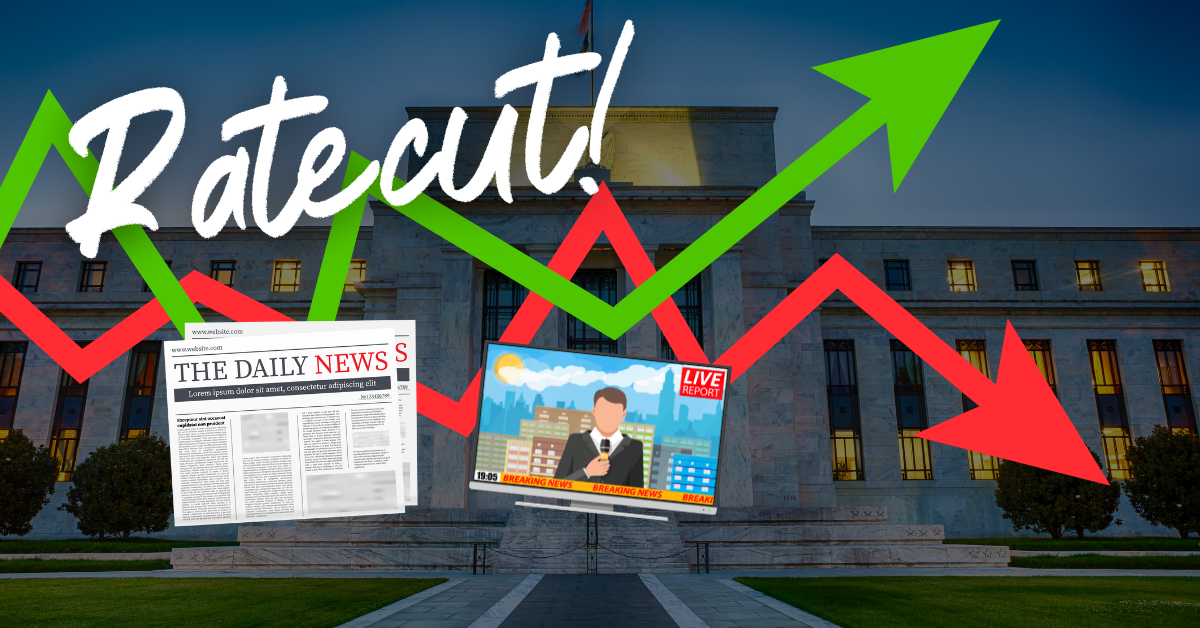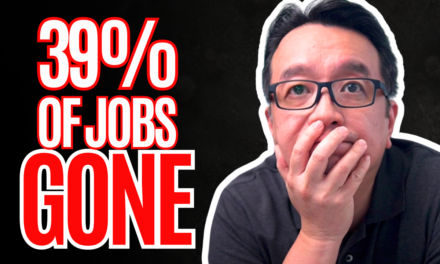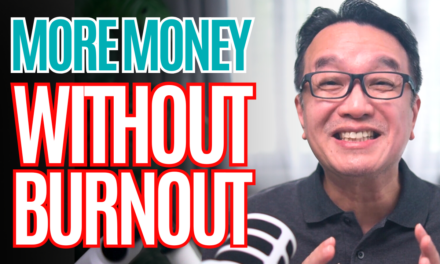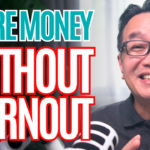
The Real Impact of Fed Rate Cuts on the Stock Market Impact: How To Thrive not Dive


The Fed just announced interest rate cuts, and as expected, headlines predicting doom and gloom are flooding the news.
Conventional media, and financial bloggers are jumping on the bandwagon, amplifying the fear.
In fact, over the last week, my coaching calls with some of my private students brought up exactly this question – how bad will it be, and should they start selling.
This upsets me—not because of the negative outlooks, but because it’s pure fear-mongering.
It’s designed to deceive the general populus, people like you and me, not help us. It’s meant to make us panic and make the wrong decisions.
In this article, we’ll explore the true impact of Fed rate cuts on the stock market, why the media does this, and finally how you can avoid being misled so that you can thrive, instead of get burnt in this volatile market.Don’t Fall for the Fear-Mongering
Don’t Fall for the Fear-Mongering
Everytime the Federal Reserve first cuts interest rates, it triggers a wave of speculation.
Some predict an economic boom, while others foresee a market crash.
The truth is, the real impact of Fed rate cuts on the stock market impact is complex and can’t be boiled down to simplistic predictions.
And yet, the moment a rate cut is announced, the media pounces with dramatic headlines that often stoke unnecessary fear.
In fact, if you ask me, that’s the only thing that’s actually predictable – that the media will come up with sensational headlines!
Doom and Gloom Headlines: Why the Media Loves Them
It’s been less than a week since the Fed announced rate cuts and I’ve literally been bombarded by sensational headlines like “The Fed Just Caused a Recession” or “Market Crash Imminent!” which are all deliberately crafted to grab our attention.
Media outlets thrive on clicks, views, and shares, and let’s face it, nothing drives engagement like fear.
That’s a primal human instinct that’s even more powerful than greed.
Think about it – when our ancestors ran from sabre tooth tigers, they stayed alive – and that was even more important than being tempted by their next meal.
The thing is – these fear driven headlines are often misleading.
They are designed to provoke an emotional reaction, pushing you to make impulsive decisions rather than informed ones, often misrepresenting the true impact of these rate cuts.
The Real Problem: Fear-Mongering Designed to Mislead
The thing is, the primary goal of fear-mongering is not to inform but to manipulate.
It’s about creating a sense of urgency and panic that leads you to take actions—like selling off your investments—and that might not be in your best interest.
The media and certain financial influencers know that fear sells, and they exploit this to their advantage, often distorting the real impact of Fed rate cuts on the stock market.
My Experience: How Fear-Mongering Cost Me Nearly Seven Figures
And this is something I learnt the hard way. Fear-driven decisions can be extremely damaging.
During the 2008 housing crisis, I was glued to the news, listening to every financial “guru” who claimed to know what was coming next. The media was rife with catastrophic predictions, and I let that fear drive my decisions.
The result? I lost nearly seven figures.
Instead of staying calm and sticking to simple solid strategy like owning only good companies, I panicked and made moves that cost me dearly.
Listening to the Media and “Gurus” Led to Massive Losses
The media and so-called experts played a huge role in those losses.
They preyed on my fears and convinced me that the only way to protect myself was to get out of the market.
On hindsight, which is of course 20/20, I realized that these voices were more interested in driving their narratives and less concerned with helping people like me make sound financial decisions.
Learning from the Past: How I Approached the 2020 COVID Crash Differently
When the COVID crash hit in 2020, I knew better.
This time, I didn’t fall for the fear-mongering.
Instead, I focused on preparation and understanding. I recognized that while the short-term outlook was uncertain, the I looked for companies where long-term fundamentals remained strong.
This time, I stayed invested, and even added to my positions, and it paid off.
No one knows if a recession will hit.
But if you have a good simple strategy, if you buy and hold good companies, if you’re prepared with a understanding, you won’t let not letting the media, or online gurus dictate my financial decisions.
Understanding the Fed Rate Cuts and Stock Market Impact
In order for you to do the same, you need to understand that the Fed cuts rates to stimulate the economy.
When economic growth slows or inflation is under control, lower interest rates make borrowing cheaper, encouraging spending and investment.
Recessions are caused by the exact opposite of what this is designed to do.
The Fed cuts rates to prevent a recession by boosting economic activity.
Rate Cuts Don’t Cause Recessions: Debunking the Myths
Once you understand this, you’ll see that the whole idea of the Fed cutting rates causing a recession is complete and utter rubbish.
The goal is to maintain economic balance, not to cause panic.
Fed rate cuts are a normal part of economic management, not just the sensationalized headlines.
A better headline might be – there might be a recession coming, and so the Fed has cut rates to avoid one – but that’s just not sexy is it?
The Garden Analogy: How the Fed Nurtures Economic Growth
This is an analogy that has helped alot of my students understand this a little better.
Think of the economy as a garden that needs just the right amount of water to thrive.
The Federal Reserve acts like a gardener controlling the flow of water (money) through a hose (interest rates).
When the economy is growing too fast, like a bushy garden getting too much water, the Fed turns down the hose down (or tightens monetary policy) by raising interest rates. This reduces the flow of money, helping to combat inflation.
Conversely, when the economy is slowing down and needs a boost—similar to a browning garden that’s not getting enough water—the Fed turns up the hose (or loosens monetary policy) by lowering interest rates.
This increases the flow of money, encouraging more borrowing, investment, and spending.
The impact of Fed rate cuts on the stock market are like the water that helps the garden flourish, with the Fed adjusting rates to keep the economy balanced and growing at a healthy pace.
The Media’s Role in Fueling Market Panic
Again, garden analogies aren’t very sexy, and we live in a clickbait culture where sensational headlines are the norm.
These headlines are designed to provoke fear and urgency because fear drives clicks. But this approach often leads to a distorted view of reality.
Understanding that the media’s business model relies on clicks and views can help you see why the coverage of impact of Fed rate cuts on the stock market, is often exaggerated.
- Headlines are crafted to be emotionally charged, often using words like “crash,” “collapse,” or “recession” to make you feel that immediate action is necessary. This is a psychological tactic to keep you engaged with their content, even if it means misleading you about the true impact of Fed rate cuts on the stock market.
- What many investors may not realize is that some of the largest media companies are owned or heavily influenced by major investment funds like BlackRock, Vanguard, and Fidelity. These funds have significant stakes in the financial markets and can benefit from creating an atmosphere of fear. When investors panic and sell off their assets due to perceived impact of Fed rate cuts on the stock market, prices drop, allowing these large funds to buy high-quality stocks at a discount.
- Similarly, a guru might be motivated to get you to invest in his program.
- Given these dynamics, it’s essential to question the motivations behind sensational headlines. Understanding the real drivers behind media coverage can help you avoid making decisions based on fear and instead focus on long-term strategies that are informed by solid economic principles, giving you a clearer perspective on the actual impact of Fed rate cuts.
How to Prepare and Protect Yourself from Market Panic
The most effective way to protect yourself from market panic is through preparation and understanding.
This means educating yourself about how the economy works, understanding the role of the Federal Reserve, and recognizing the long-term nature of investing.
By being prepared, you can avoid the knee-jerk reactions that fear-mongering headlines are designed to provoke, and better manage the impact of Fed rate cuts on the stock market for yourself.
Diversification and Long-Term Planning: Building a Resilient Portfolio
One of the best strategies for managing impact of Fed rate cuts on the stock market is diversification.
By spreading your investments across different asset classes and sectors, you reduce your exposure to risk.
But don’t just diversify for the sake of diversifying. We teach our students to only invest in good assets, because adding bad assets to your portfolio for the sake of diversification, will often have negative effects. Bad assets are the first to tank.
Also, bear in mind portfolio correlation when diversifying. If your assets are all correlated, then diversification will not help you much. Long-term planning is also crucial. Instead of trying to time the market, focus on building a portfolio that can withstand market fluctuations and grow over time.
Where to Find Reliable Information: Trustworthy Sources vs. Sensationalist Media
In today’s media landscape, it’s more important than ever to find reliable sources of information.
Consult economic reports directly from institutions like the Federal Reserve, and read the Investor Relations publications of companies that you are invested in. I often tell my students not to talk about investing in a stock, because the reality is that you’re investing in a living breathing company, run by human management, you’re not punting, and you need to treat your investments that way.
And by doing so, you’ll avoid making decisions based on sensationalist headlines that are more interested in generating clicks than providing accurate analysis of the actual impact of Fed rate cuts on the stock market.
Conclusion: Navigate the Market with Confidence, Not Fear
While the impact of Fed rate cuts on the stock market can be significant, they are not a guaranteed harbinger of doom.
While the media may try to convince you otherwise, it’s important to approach such situations with a clear head and a well-thought-out strategy.
By understanding the true purpose of rate cuts and staying informed without succumbing to fear, you can navigate the market effectively, regardless of short-term fluctuations, and do so without the complicated strategies many will have you believe are necessary to successfully make good money from your investments.
FAQs
How can I avoid making bad investment decisions during rate cuts?
The best way to avoid making poor decisions is to stay informed with the truth, focus on the long term, and avoid reacting impulsively to sensationalist media coverage.
What are the signs that a market crash is being exaggerated?
Look for sensationalist language in headlines, lack of in-depth analysis, and an overemphasis on worst-case scenarios without considering historical context.
How should I adjust my investment strategy in response to rate cuts?
Consider diversifying your portfolio, focusing on sectors that benefit from lower rates, and maintaining a long-term perspective rather than trying to time the market.
What sources can I trust for financial news and analysis?
Government reports, and company reports are your best bet for reliable information.
Why is it important to have a long-term investment strategy?
A long-term strategy allows you to ride out short-term market fluctuations and benefit from the overall growth of the market over time, reducing the impact of temporary downturns.

























Recent Comments